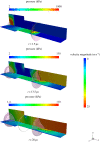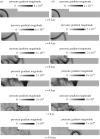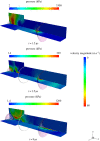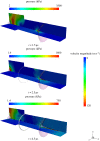Numerical investigations on bubble-induced jetting and shock wave focusing: application on a needle-free injection
- PMID: 30853840
- PMCID: PMC6405452
- DOI: 10.1098/rspa.2018.0548
Numerical investigations on bubble-induced jetting and shock wave focusing: application on a needle-free injection
Abstract
The formation of a liquid jet into air induced by the growth of a laser-generated bubble inside a needle-free device is numerically investigated by employing the compressible Navier-Stokes equations. The three co-existing phases (liquid, vapour and air) are assumed to be in thermal equilibrium. A transport equation for the gas mass fraction is solved in order to simulate the non-condensable gas. The homogeneous equilibrium model is used in order to account for the phase change process between liquid and vapour. Thermodynamic closure for all three phases is achieved by a barotropic Equation of State. Two-dimensional axisymmetric simulations are performed for a needle-free device for which experimental data are available and used for the validation of the developed model. The influence of the initial bubble pressure and the meniscus geometry on the jet velocity is examined by two different sets of studies. Based on the latter, a new meniscus design similar to shaped-charge jets is proposed, which offers a more focused and higher velocity jet compared to the conventional shape of the hemispherical gas-liquid interface. Preliminary calculations show that the developed jet can penetrate the skin and thus, such configurations can contribute towards a new needle-free design.
Keywords: OpenFOAM; cavitating jet; microfluidics; needle-free injection.
Conflict of interest statement
We declare we have no competing interests.
Figures











Similar articles
-
Modelling cavitation during drop impact on solid surfaces.Adv Colloid Interface Sci. 2018 Oct;260:46-64. doi: 10.1016/j.cis.2018.08.004. Epub 2018 Aug 25. Adv Colloid Interface Sci. 2018. PMID: 30195460 Review.
-
Toward jet injection by continuous-wave laser cavitation.J Biomed Opt. 2017 Oct;22(10):1-9. doi: 10.1117/1.JBO.22.10.105003. J Biomed Opt. 2017. PMID: 29030942
-
The dynamics of a non-equilibrium bubble near bio-materials.Phys Med Biol. 2009 Oct 21;54(20):6313-36. doi: 10.1088/0031-9155/54/20/019. Epub 2009 Oct 7. Phys Med Biol. 2009. PMID: 19809103
-
Jetting bubbles observed by x-ray holography at a free-electron laser: internal structure and the effect of non-axisymmetric boundary conditions.Exp Fluids. 2024;65(2):20. doi: 10.1007/s00348-023-03759-9. Epub 2024 Feb 1. Exp Fluids. 2024. PMID: 38313751 Free PMC article.
-
Modification of the Young-Laplace equation and prediction of bubble interface in the presence of nanoparticles.Adv Colloid Interface Sci. 2015 Nov;225:1-15. doi: 10.1016/j.cis.2015.07.006. Epub 2015 Aug 1. Adv Colloid Interface Sci. 2015. PMID: 26320606 Review.
Cited by
-
Development of Repetitive Mechanical Oscillation Needle-Free Injection through Electrically Induced Microbubbles.Cyborg Bionic Syst. 2025 Mar 19;6:0225. doi: 10.34133/cbsystems.0225. eCollection 2025. Cyborg Bionic Syst. 2025. PMID: 40110347 Free PMC article.
References
LinkOut - more resources
Full Text Sources

